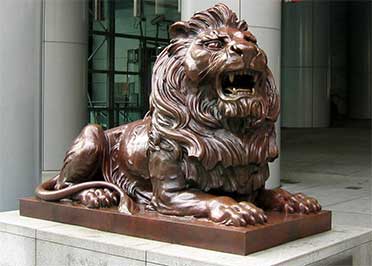This is a speech by Stephen Green, group chairman of HSBC holdings, at the FT/DIFC World Financial Centres summit, dated 20th Oct, 2008. He makes a lot of sense all the time, so I think it's worthwhile listening to what he had to say about the world in general. It's a bit drawn out, but I assure you, there are lots of gems in it.
Here's the
actual link of this speech which I've cut and pasted here:
---------------------------------------------------
Good morning ladies and gentlemen. I’d like to thank the FT and Dubai International Financial Centre for inviting me to speak at today’s conference.
Our industry is going through a crisis the like of which none of us has experienced before. Many people are asking if this is the worst financial crisis since 1929. It probably is. If it is the most complex financial crisis the world has seen? Certainly, it is. If it will usher in a recession? I’m afraid this seems inevitable. Indeed, although the economic data lags the facts on the ground, it seems likely that the UK and a number of other economies are already contracting. This risks creating a further phase in which conventional credit impairments rise as a result of recession. As the crisis has intensified, so has the analysis of the causes behind it, which are complex.
Many factors have contributed to the financial crisis. Some of the most significant … but this is by no means an exhaustive list… include: The explosive growth of sub-prime lending, notably in the US. Eighteen months ago, sub-prime was the main villain; today it has been subsumed by the wider crisis, and appears half-forgotten. Yet it was the downturn in the US housing market, and the pressure that put on less well-off homeowners that triggered the start of this crisis.
Sub-prime is, however, far from the only villain in town. The complexity and opacity of certain financial instruments reached a point where even senior and experienced bankers had trouble understanding them, let alone investors. This meant that people were selling and buying assets whose risks they had not properly assessed.
On top of that, these assets were created on the back of ever higher leverage, both direct and indirect. And when the securitisation market began to collapse, banks found themselves with assets that they could neither sell nor fund, so creating large losses on the asset side and a funding stretch on the liability side for which they were entirely unprepared.
In several markets there was an overdependence on wholesale funding, based on the assumption that funding would never dry up – an assumption that has proved fatal to some once distinguished names in banking.
Finally, weakening economies and declining asset values, particularly housing, risk feeding back into lower asset quality more generally, giving rise to further impairment charges.
Each of these factors has undoubtedly contributed to the breadth and depth of this financial crisis.

However, something even more fundamental is underway in the world economy, of which this crisis is a manifestation and on which we need to focus if we are to understand its real significance. And to understand this, we need to take a step back and consider the global macro-economic context.
The principal feature of the global economy in recent years is that it has become something of a perpetuum mobile. In the post-war period there has been an increasing interdependence between national economies, on the back of falling trade barriers and freer capital flows.
The post-war recovery of Germany and the rise of Japan foreshadowed the rise of dynamic Asian economies such as Hong Kong, Korea and Taiwan, the so-called newly industrialised countries. And of course, in the last 20 years, the economic renaissance of the world’s two largest nations – China and India – has changed the landscape still further.
We have also seen the rapid rise of resource-rich nations, primarily energy-producers, thanks to the growing demand for oil and other minerals.
Meanwhile, in mature economies the consumer has become king. Consumption in western markets has been the main driver of economic growth over the last few years, funded by exceptionally cheap borrowing, made possible by savings surpluses built up in the developing world.
These changes to the economic landscape have effectively created an economic triangle. On one side, those economies that are the workshops of the world, most of which are relatively resource-poor. On another side are the resource suppliers, notably the Middle East, which produces almost a third of the world’s oil and will produce an increasingly significant proportion of the world’s gas as well. And on the third side, you have consuming nations with low savings ratios – particularly, of course, the US, which has become what you might call the “spender of last resort”. This triangle has sustained high rates of world economic growth, but it has also helped create huge, and growing, financial imbalances. The newly industrialised countries – the workshops of the world – with their high savings rates and low exchange rates have built up massive currency reserves.
So have the resource-rich exporters, where – in many cases – a combination of small populations, and until recently strong global demand for oil and high energy prices, has created surplus liquidity which is available for investment in international markets in one form or another.
Meanwhile, counterbalancing these surpluses have been the consumers of the developed world, where debt has grown exponentially among consumers. In the UK, for example, the ratio of debt to income reached 173 per cent this year, up from 129 per cent five years ago, and higher than any other G7 economy.
These factors have been accompanied by increased financial market leverage. Why? Again, there are multiple reasons.
Primary among them, the search for yield among investors. The equity collapse at the beginning of the decade prompted institutional investors to move out of equities and into fixed income investments. But the bond markets were drawing in surplus liquidity from emerging markets – over 50 per cent of US treasury debt is now owned by foreign investors – significantly reducing bond yields. Mortgage backed securities seemed to fit the bill of higher yields with limited risk that was sought by investors. This in turn stimulated huge growth in these securities, and also changed the funding model for banks. In 1990, just 10 per cent of mortgages in the United States were securitised, compared with 70 per cent in 2007.
And in general, the liquidity build-up served to artificially compress risk spreads, fuelling asset price inflation, especially in real estate, that eventually became a bubble. Even at zero growth rates, the imbalances in the real economy would have led to an increase in assets and liabilities. And at high growth rates, the after-burners were well and truly on. The combination of a tidal wave of liquidity and the search for yield produced rising risk/reward ratios, with investors moving up the scale, even as the scale itself was rising.
So the effect of this macro-economic triangle was to make the financial markets intrinsically and increasingly unstable. And on top of this, global monetary conditions contributed further to instability.
The period of loose monetary policy between 2002 and 2004 offset the corporate deleveraging that had followed the dot com bust and 9/11 by encouraging increased consumer leverage. The tendency for emerging markets to run monetary policies explicitly or implicitly tied to US policy, because of their foreign exchange policies, created the scope for loose monetary conditions to spread globally. This reduced the cost and the risk of investing surplus liquidity in the US dollar – thus feeding what would become a spiral of cheap credit, rising asset prices and high consumer borrowing.
The blow-up was inevitable and has been very painful.
And as in previous crises, the specific trigger for today’s crisis – sub-prime – has become relatively less important as the crisis unfolds. Now the principal concerns are about the massive breakdown in confidence and trust that has led to market failure, manifested by the system-wide “wholesale bank-run” which has clogged the interbank markets and turned the bursting of an asset price bubble into a full-blown liquidity crisis. And so we arrive at today’s situation where governments have been forced to guarantee term lending, to inject huge volumes of liquidity into the system, and to recapitalise many financial institutions, becoming potential or actual “owners of last resort”.

“This too shall pass,” as the saying goes. But there will be no return to the status quo ante. There are many lessons for banks, regulators, investors, monetary authorities, accountants and consumers to learn from this crisis. The high-leverage model of finance is bankrupt. But securitisation will survive. You cannot bring the whole of the world’s capital markets back on to banks’ balance sheets.
But some new lessons need to be learnt – or perhaps they are old ones! Financial strength is making a welcome comeback. Benchmarks of acceptable leverage and capital ratios are being revised. And regulators will need to address the pro-cyclicality of capital requirements caused by the interaction of fair value accounting and Basel 2 capital adequacy rules. There will be a renewed focus on liquidity. This crisis has shown that it is liquidity that kills banks, not just a shortage of capital. Regulators and banks themselves need to understand their liquidity vulnerabilities more clearly. And the market and industry will need to consider whether badly-aligned incentives have contributed to the crisis: both the market incentives which, until recently, encouraged banks to grow fast and gear up, persuading them to take on higher risk than was sustainable; and compensation structures in the industry, which have so often encouraged too much opacity and excessive risk taking.
But underlying all of this is a fundamental trend in the world economy which, in my view, will not be de-railed even by today’s crisis and which we need to recognise for what it is. And that is the rebalancing of the global economy towards Asia, home to over half the world’s population, and its implications for the Middle East. In the long-term, it is this shift that will affect financial markets most profoundly. Asia and the Middle East will continue to outgrow mature markets. Even in the current economic climate, our short-term projections are for slowing but still quite resilient growth: an expected 6.4 per cent this year slowing to 5.7 per cent next. Given that the emerging markets economies are collectively as large as the US economy, continued growth should help exporters from the G7 countries. But crucially this growth will also stimulate regional and domestic demand for capital.
As Asian and Middle Eastern economies grow larger, we will see the continued development of regional and domestic capital markets. In the light of this financial crisis it would be hardly surprising if caution and scepticism about the Western model of capital markets were to increase amongst emerging markets.
Nevertheless, I believe the direction is clear –regional capital markets will develop and more of the capital generated in the fast growing emerging markets will stay closer to home in the future.
What are the implications of these profound shifts for mature economies over the longer-term? I am not a doomsayer. It is important to remember that economic growth is not a zero-sum game. Therefore the rapid growth of emerging markets does not signal an absolute decline in the economies of mature nations.
The pie will grow. But it does entail a loss of share – the developed world will have a smaller share of a larger pie. Indeed, this has been the experience of the US since the 1950s.
Capital markets in the developed world will likewise suffer a loss of share. And in the near-term, at least, an absolute decline is also likely as the deleveraging of the financial system works its way through.
And what are the implications of all this for the fast growing regions of Asia and the Middle East?
First, that creating financial systems which are both more sophisticated and more stable will be a major challenge – but it is not one that can be avoided. As economies become larger and more sophisticated, they need fully functioning capital markets to ensure the efficient allocation of capital. For all that the western markets are in crisis, neither the world at large nor Asia in particular can turn the clock back to a simpler era in which capital markets played only a marginal role in economic development.
The main challenge lies in the dichotomy that financial markets – as this crisis has demonstrated – are increasingly global, while the policymakers and regulation that governs them remain predominantly national. Greater international cooperation will be required to place the financial system on a more stable footing. And given that financial crises are a recurrent feature in our lives, we will need more global regulatory coordination to deal with them when they do arise.
At the same time, as Asian and Middle Eastern economies grow and become more important as investors in the world economy, their responsibilities will also become more complex. And their voices will need to be heard in the dialogue about world trade and investment policy that must surely continue.
For there is a clear threat that the financial crisis may rekindle protectionist tendencies. In this new, and more fragile world order, preserving the free-trade and open investment orientation that has helped humanity to become more prosperous than ever before in the last 50 years will be a major challenge, especially if the world faces a major slow-down.
Globalisation is not a new phenomenon; it allowed the world to prosper in the late 19th century when, despite high tariffs, rapidly falling transport costs prompted an explosion in world trade. This earlier wave of globalisation was brought to a halt by the first world war, and then regressed through the 1930s, as a result of protectionist and competitive devaluation with eventually unspeakable consequences. Since the 1950s, there has been steady progress in liberalising trade and investment, led by a strong power – the US – that has created prosperity the like of which had never been seen before.
Free markets are in the dock today, as the full extent and pain of this crisis is revealed. But as we look beyond the turmoil, and as policymakers consider how to prevent future crises, we must strive at all costs to avoid repeating the protectionist errors of the 1930s. Instead, we must remind ourselves constantly of the immense wealth and prosperity that free markets have helped create for humankind.
This crisis is severe; it is without doubt the most serious for many generations, and it is hard to look beyond the sea of red on trading screens to the future. Nevertheless, the crisis will pass; trust and confidence must and will be rebuilt. More importantly though, it is important to understand this crisis for what it is – and what it isn’t. It is not just about a housing bubble in the US, nor just about a consumer debt explosion in the developed world. It is part of a much more fundamental shift in the world economy, from one dominated by a single nation, to one in which wealth is created and shared much more widely – a world which is more complex and in which international cooperation to ensure stable, efficient, open capital markets becomes more and more important for us all.


















